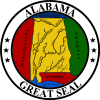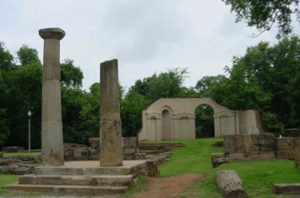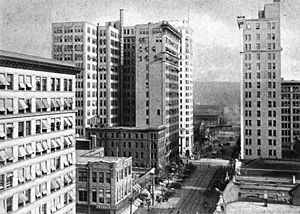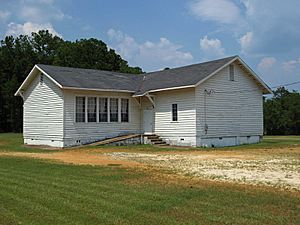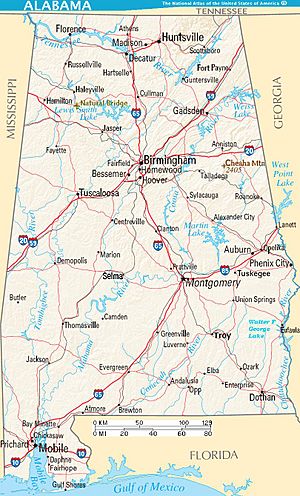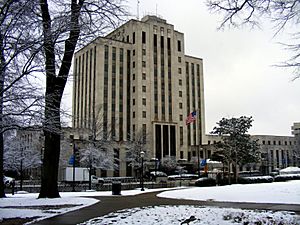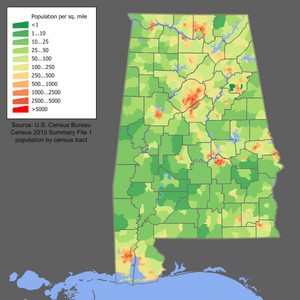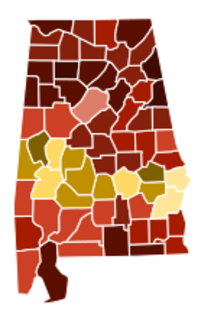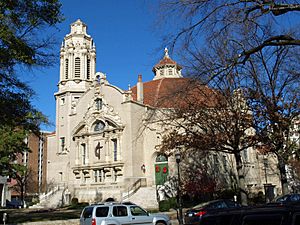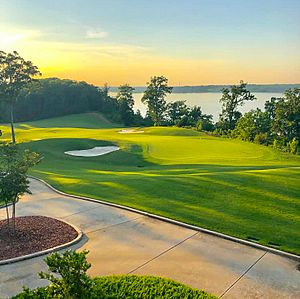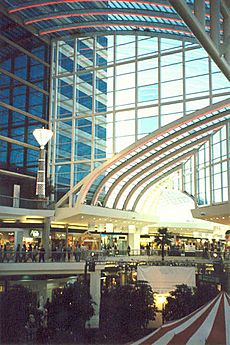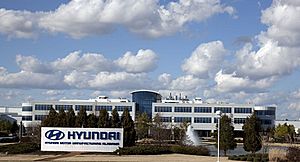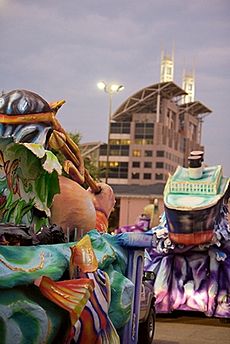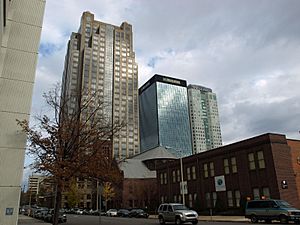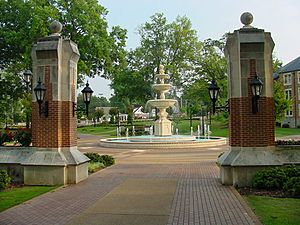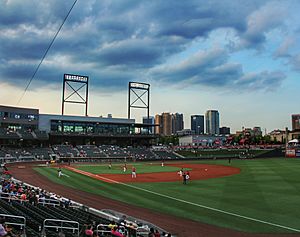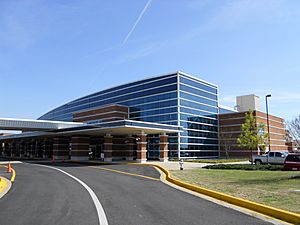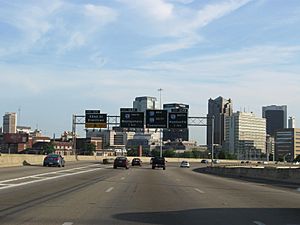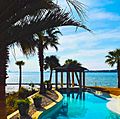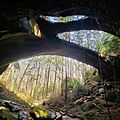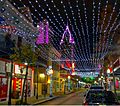Alabama facts for kids
Quick facts for kids
Alabama
|
|||
|---|---|---|---|
|
|||
| Nicknames:
the Yellowhammer State, the Heart of Dixie, the Cotton State
|
|||
| Motto(s): | |||
| Anthem: "Alabama" | |||

Location of Alabama within the United States
|
|||
| Country | United States | ||
| Before statehood | Alabama Territory | ||
| Admitted to the Union | December 14, 1819 (22nd) | ||
| Capital | Montgomery | ||
| Largest city | Huntsville | ||
| Largest county or equivalent | Jefferson | ||
| Largest metro and urban areas | Greater Birmingham | ||
| Legislature | Alabama Legislature | ||
| • Upper house | Senate | ||
| • Lower house | House of Representatives | ||
| Judiciary | Supreme Court of Alabama | ||
| U.S. senators | Tommy Tuberville (R) Katie Britt (R) |
||
| U.S. House delegation | 5 Republicans 2 Democrats (list) |
||
| Area | |||
| • Total | 52,419 sq mi (135,765 km2) | ||
| • Land | 50,744 sq mi (131,426 km2) | ||
| • Water | 1,675 sq mi (4,338 km2) 3.2% | ||
| Area rank | 30th | ||
| Dimensions | |||
| • Length | 330 mi (531 km) | ||
| • Width | 190 mi (305 km) | ||
| Elevation | 500 ft (150 m) | ||
| Highest elevation | 2,413 ft (735.5 m) | ||
| Lowest elevation | 0 ft (0 m) | ||
| Population
(2024)
|
|||
| • Total | |||
| • Rank | 24th | ||
| • Density | 99.2/sq mi (38.3/km2) | ||
| • Density rank | 27th | ||
| • Median household income | $62,200 (2023) | ||
| • Income rank | 46th | ||
| Demonym(s) | Alabamian, Alabaman | ||
| Language | |||
| • Official language | English | ||
| • Spoken language | As of 2010[update]
|
||
| Time zones | |||
| Entire state (legally) | UTC– 06:00 (Central) | ||
| • Summer (DST) | UTC– 05:00 (CDT) | ||
| Phenix City area (unofficially) | UTC– 05:00 (Eastern) | ||
| • Summer (DST) | UTC– 04:00 (EDT) | ||
| USPS abbreviation |
AL
|
||
| ISO 3166 code | US-AL | ||
| Traditional abbreviation | Ala. | ||
| Latitude | 30°11' N to 35° N | ||
| Longitude | 84°53' W to 88°28' W | ||
| Dance | Square dance |
|---|---|
| Bird | Yellowhammer, wild turkey |
| Fish | Largemouth bass, fighting tarpon |
| Flower | Camellia, oak-leaf hydrangea |
| Tree | Longleaf pine |
| Insect | Monarch butterfly |
Alabama is a state in the Southeastern United States. It borders Tennessee to the north and Georgia to the east. To the south are Florida and the Gulf of Mexico. Mississippi is to the west.
Alabama is the 30th largest state by area. It is the 24th most populated of the U.S. states. Alabama has many inland waterways, stretching over 1,500 miles (2,400 km).
The state is called the Yellowhammer State. This is because of its state bird. Alabama is also known as the "Heart of Dixie" and the "Cotton State". The state tree is the longleaf pine. The state flower is the camellia.
Montgomery is Alabama's capital city. Huntsville is its largest city by population and area. Mobile is the oldest city. French colonists founded it in 1702. Greater Birmingham is the largest city area. It is also the main economic center.
Many native tribes lived in Alabama long ago. European countries like Spain, France, and Britain claimed the land. Alabama became a U.S. state in December 1819. In the past, Alabama grew a lot of cotton. This led to the widespread use of slave labor.
In 1861, Alabama left the United States. It joined the Confederate States of America. Montgomery was its first capital. Alabama rejoined the Union in 1868. After the American Civil War, the state faced tough economic times. This was partly because its economy relied mostly on farming.
Later, laws called Jim Crow laws were used. These laws treated African Americans unfairly. They were used until the 1960s. The civil rights movement became very important in Alabama. Events like the Selma to Montgomery march helped bring about change.
After World War II, Alabama's economy grew. New industries developed. NASA's Marshall Space Flight Center in Huntsville helped a lot. It brought the aerospace industry to the state. Today, Alabama's economy includes cars, money, tourism, and technology.
Alabama has different types of land. The north has mountains in the Tennessee Valley. The south has Mobile Bay, a big port. Alabama is known for its Southern culture. American football, especially college games, is a huge part of life there.
Contents
What Does "Alabama" Mean?
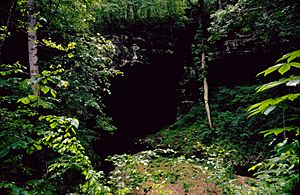
The name "Alabama" comes from the Alabama people. This was a Native American tribe. They spoke a Muskogean language. They lived near the Coosa and Tallapoosa rivers.
In their language, a person from the Alabama tribe is called Albaamo. The word "Alabama" is believed to come from this language.
Alabama's Past: A Quick Look
Early People in Alabama

Many Native American groups lived in Alabama. They lived there for thousands of years. This was long before Europeans arrived. They traded with tribes from the northeast.
Some of the tribes living in Alabama were the Cherokee, Alabama, Chickasaw, Choctaw, Creek, and Koasati. These tribes had their own cultures and languages.
European Arrivals and Changes
Spanish explorers were the first Europeans here. Hernando de Soto passed through in 1540. Over 160 years later, the French started the first European settlement. This was at Old Mobile in 1702. The city moved to its current spot in Mobile in 1711.
The French claimed this area until 1763. Then, the British took control after a war. After the American Revolutionary War, the land was split. The United States and Spain shared it. Spain kept Mobile until 1813.
Most of what is now Alabama became part of the Mississippi Territory in 1798. The Alabama Territory was created in 1817. St. Stephens was its first capital.
Becoming a State and Civil War
Alabama became a state on December 14, 1819. It was the 22nd state to join the U.S.
Early settlers brought slaves to Alabama. They worked on cotton farms. These farms grew quickly.
Tuscaloosa was Alabama's capital from 1826 to 1846. On January 11, 1861, Alabama left the Union. It joined the Confederate States of America. Montgomery was the first capital of the Confederacy. Alabama was very involved in the American Civil War.
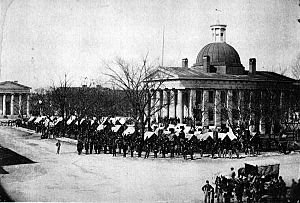
Slaves in Alabama became free in 1865. This was due to the 13th Amendment. Alabama was under military rule until 1868. After the war, farming, especially cotton, remained key.
20th Century Changes
In the early 1900s, many schools were built for African-American children. They were called Rosenwald Schools.
Many African Americans moved away from Alabama. They went to northern cities. This was part of the Great Migration. They sought better jobs and less discrimination. At the same time, many people moved to Birmingham. They found new factory jobs there.
World War II brought new jobs and money to Alabama. The state's economy grew. In 1954, a court ruling said schools must be open to all races. Alabama was slow to follow this rule.
Legal segregation ended in 1964. But unfair customs continued. The civil rights movement fought these practices. During and after World War II, Alabama's economy changed. New industries like aerospace grew.
Alabama's Landscape and Weather
Alabama is the 30th largest state in the U.S. Water makes up 3.2% of its area. This gives Alabama the second-largest inland waterway system. Most of the land is a gentle plain. It slopes towards the Mississippi River and the Gulf of Mexico. North Alabama has mountains. The Tennessee River cuts through them.
Alabama shares borders with Tennessee, Georgia, Florida, and Mississippi. It also has a coastline on the Gulf of Mexico. The land goes from sea level at Mobile Bay to over 1,800 feet (550 m) high. This is in the Appalachian Mountains in the northeast.
The highest point is Mount Cheaha. It is 2,413 ft (735 m) tall. Forests cover about 67% of Alabama's land. Baldwin County is the largest county. It is on the Gulf Coast.
Alabama has four National Forests. They are Conecuh, Talladega, Tuskegee, and William B. Bankhead. A cool natural spot is ""Natural Bridge" rock". It is the longest natural bridge east of the Rockies.
There is a meteorite impact crater in Elmore County. It is near Montgomery. A meteorite hit this area 80 million years ago. This created the Wetumpka crater.
Alabama's Climate
Alabama has a humid subtropical climate. This means it has very hot summers. Winters are mild. It rains a lot throughout the year. Alabama gets about 56 inches (1,400 mm) of rain each year. Plants can grow for up to 300 days in the south.
Summers in Alabama are very hot. High temperatures often go over 90 °F (32 °C). Alabama can also get tropical storms and hurricanes. South Alabama has many thunderstorms.
Alabama has had many strong tornadoes. It has had more EF5 tornadoes than almost any other state. The state had a record 62 tornadoes in 2011. Alabama also has a second tornado season in November and December.
Winters are usually mild. The highest temperature ever was 112 °F (44 °C) in 1925. The lowest was −27 °F (−33 °C) in 1966.
Plants and Animals

Alabama has many different plants and animals. This is because it has many types of natural areas. These range from the Tennessee Valley in the north to the beaches in the south. Alabama is known for its wide range of biodiversity.
The state has large pine forests. It ranks fifth in the U.S. for plant diversity. It has almost 4,000 types of plants.
Alabama is home to many animal species. These include 62 types of mammals and 93 types of reptiles. There are 73 types of amphibians. About 307 types of freshwater fish live here. Also, 420 types of birds visit or live in Alabama.
How Alabama is Governed
State Government Structure
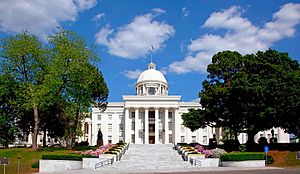
Alabama's government follows the Constitution of Alabama. The current one was adopted in 2022. The state government has three equal parts.
The legislative branch makes laws. It is called the Alabama Legislature. It has two parts: the Alabama House of Representatives (105 members) and the Alabama Senate (35 members). They debate and pass state laws.

The executive branch carries out the laws. The governor of Alabama leads it. Other leaders include the lieutenant governor and Attorney General.
The judiciary explains the laws. The highest court is the Supreme Court of Alabama. Judges are chosen in elections.
Alabama does not allow state lotteries.
People of Alabama
In 2020, Alabama's population was 5,024,279 people. Most people live in the northern, central, and southern parts of the state. They live in cities like Huntsville, Birmingham, Montgomery, and Mobile.
Different Backgrounds
Many Native American tribes lived in Alabama before Europeans. Later, white and black Americans moved to the area. By 2020, about 66.5% of Alabama's population was white. About 26.9% was African American. The number of Hispanic and Latino people is growing.
Languages Spoken
Most people in Alabama speak English at home. This was 95.1% in 2010. The English spoken in Alabama is mostly Southern. Some unique words include "redworm" for earthworm and "snake doctor" for dragonfly.
| Language | Percentage of population (as of 2010[update]) |
|---|---|
| Spanish | 2.2% |
| German | 0.4% |
| French (incl. Patois, Cajun) | 0.3% |
| Chinese, Vietnamese, Korean, Arabic, African languages, Japanese, and Italian (tied) | 0.1% |
Religion in Alabama

Alabama is in the "Bible Belt". This is a region with many Protestant Christians. About 86% of people in Alabama are Christian. Many people attend church regularly.
The largest Christian groups are the Southern Baptist Convention and The United Methodist Church. There are also many non-denominational churches.
Other religions are present too. These include Judaism, Islam, Hinduism, and Buddhism. Jews have been in Alabama since 1763. The oldest Jewish group is in Mobile. Muslims are also growing in number. There are Hindu temples and Buddhist centers.
Alabama's Economy and Jobs
Alabama has invested in many industries. These include aerospace, healthcare, banking, and car making. It also has mining and steel production. In 2006, farming products were worth $1.5 billion. This was only about one percent of the state's total economy.
Many people work in management, business, and healthcare. Others work in education, sales, and manufacturing. In 2008, Alabama's total economic output was $170 billion.
Alabama's unemployment rate was 5.8% in April 2015. Alabama does not have a state minimum wage.
Major Employers
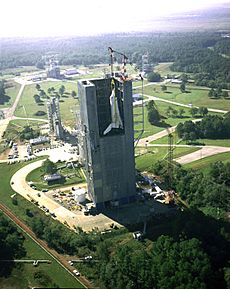
Here are some of the largest employers in Alabama in 2011:
- Redstone Arsenal (25,373 employees)
- University of Alabama at Birmingham (18,750 employees)
- Maxwell Air Force Base (12,280 employees)
- State of Alabama (9,500 employees)
- Mobile County Public School System (8,100 employees)
Other big employers include universities, hospitals, and car factories.
Farming in Alabama
Alabama grows many farm products. These include poultry and eggs, cattle, and fish. They also grow peanuts, cotton, and grains. Vegetables, milk, and peaches are also important. Even though it's called "The Cotton State", Alabama is not the top cotton producer.
Fish Farming (Aquaculture)
Aquaculture is a big part of Alabama's economy. This is farming fish. People started doing this in the 1960s. Farm-raised catfish is very popular. In 2020, Alabama produced one-third of the U.S. farm-raised catfish. The sales were $307 million.
Industries in Alabama
Alabama makes many industrial products. These include iron and steel. It also produces paper, wood products, and plastic items. Cars and trucks are also made here. The state also makes aerospace and electronic products. These are mostly in the Huntsville area.
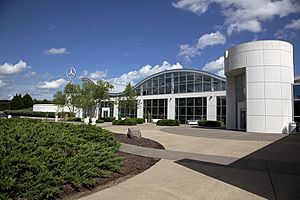
The car manufacturing industry has grown a lot since the 1990s. Companies like Honda, Hyundai, and Mercedes-Benz have factories here. This has created over 67,800 new jobs. Alabama ranks 4th in the U.S. for car exports.
Steel companies like Outokumpu and Nucor have plants in Alabama. They employ over 10,000 people. Airbus also has an aircraft assembly plant in Mobile. It started building planes in 2015.
Fun and Tourism
Alabama is a popular state to visit. In 2017, about 26 million tourists came. They spent $14.3 billion. This created many jobs.
The state has many attractions. These include the Hangout Music Festival on the beaches of Gulf Shores. The Alabama Shakespeare Festival is one of the largest in the world. The Robert Trent Jones Golf Trail has great golf courses.
Mobile is famous for its Mardi Gras celebration. It started in 1703. Mardi Gras is a holiday in Mobile and Baldwin counties.
In 2018, Mobile's Mardi Gras parade was the top event. It brought in almost 900,000 tourists. The U.S. Space & Rocket Center in Huntsville was also very popular. Alabama's Gulf Coast had 6.7 million visitors.
Many movies have been filmed in Alabama. This is because of its varied landscapes. Some movies include Close Encounters of the Third Kind and Selma.
Health and Banking
UAB Hospital and Huntsville Hospital are major medical centers. UAB is the largest state employer.
Regions Financial Corporation is the largest bank in Alabama. Other big banks like PNC Financial Services and Wells Fargo are also here. Birmingham is a center for banking and finance.
Technology and Building
AT&T has a big presence in Alabama. Many technology companies are in Huntsville. These include ADTRAN and Intergraph.
Construction companies like Brasfield & Gorrie and Hoar Construction are based in Alabama. They are among the top building firms.
Learning in Alabama
Schools for Kids
Public schools in Alabama are managed by the Alabama State Board of Education. There are 1,496 schools. They teach over 744,000 students.
The state government provides money for schools. In 2007, most schools met learning goals. Alabama's education system has gotten better. However, it still has room to improve compared to other states.
Colleges and Universities
Alabama has 14 public universities. It also has community colleges and private universities. There are four medical schools and two vet colleges. There are also dental, optometry, and pharmacy schools. Five law schools are in the state.
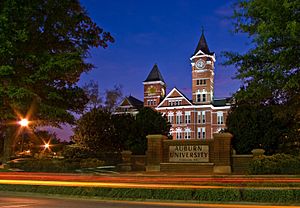
The University of Alabama in Tuscaloosa is the largest campus. It had over 37,000 students in 2016. Troy University is also very large. The oldest schools are the University of North Alabama and Spring Hill College. Both started in 1830.
Many Alabama universities are highly ranked. In 2024, Auburn University, University of Alabama at Birmingham (UAB), and the University of Alabama were in the top 100 public schools.
Sports in Alabama
College Sports
College football is very popular in Alabama. The University of Alabama Crimson Tide and Auburn University Tigers are big rivals. They play in the Southeastern Conference. Both teams have huge fan bases. Bryant-Denny Stadium, home of Alabama football, holds over 101,000 fans. Jordan-Hare Stadium for Auburn holds over 87,000.
Pro Sports and Racing
Alabama has some professional and semi-professional sports teams. This includes three minor league baseball teams.
The Talladega Superspeedway hosts NASCAR races. It can seat 143,000 people. The Barber Motorsports Park hosts other car races. Alabama has also hosted professional golf tournaments.
Getting Around Alabama
Air Travel
Major airports in Alabama include:
- Birmingham-Shuttlesworth International Airport (BHM)
- Huntsville International Airport (HSV)
- Mobile Regional Airport (MOB)
- Montgomery Regional Airport (MGM)
Train Travel
Amtrak has a daily passenger train called the Crescent. It runs from New York to New Orleans. It stops in Anniston, Birmingham, and Tuscaloosa.
Roads and Highways
Alabama has six main interstate highways. I-65 goes north to south. I-20 and I-59 go through Birmingham. I-85 connects Montgomery to Georgia. I-10 crosses the southern part of the state. I-22 connects Birmingham to Mississippi.
There are also many U.S. Highways. Some roads in Alabama require a toll.
Ports and Waterways
The Port of Mobile is Alabama's only saltwater port. It is on the Gulf of Mexico. It connects to the Midwest through the Tennessee–Tombigbee Waterway. The Port of Mobile is one of the busiest in the U.S. Other ports are on rivers. They also connect to the Gulf of Mexico.
Water ports of Alabama, listed from north to south:
| Port name | Location | Connected to |
|---|---|---|
| Port of Florence | Florence/Muscle Shoals, on Pickwick Lake | Tennessee River |
| Port of Decatur | Decatur, on Wheeler Lake | Tennessee River |
| Port of Demopolis | Demopolis, on Tombigbee River | Tennessee–Tombigbee Waterway |
| Port of Guntersville | Guntersville, on Lake Guntersville | Tennessee River |
| Port of Birmingham | Birmingham, on Black Warrior River | Tennessee–Tombigbee Waterway |
| Port of Tuscaloosa | Tuscaloosa, on Black Warrior River | Tennessee–Tombigbee Waterway |
| Port of Montgomery | Montgomery, on Woodruff Lake | Alabama River |
| Port of Mobile | Mobile, on Mobile Bay | Gulf of Mexico |
Images for kids
-
Ono Island in Baldwin County
-
Monte Sano State Park in Huntsville
-
The Natural Bridge Rock in Winston County is the longest natural bridge east of the Rockies.
-
Cliffs at the rim of the Wetumpka meteorite crater
-
Lighthouse on Guntersville Lake
-
Bryant–Denny Stadium at the University of Alabama in Tuscaloosa
-
Von Braun Center in Huntsville
-
Birmingham–Jefferson Convention Complex in Birmingham
See also
 In Spanish: Alabama para niños
In Spanish: Alabama para niños



